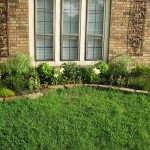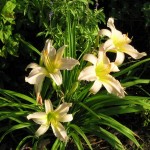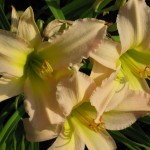With the 100 degree heat behind us, the garden is bouncing back with a show of color. Of particular note are the azaleas in the front yard, already bursting with reddish-orange flowers. In the previous two weeks, we’ve seen sporadic blooms from the Autumn Monarch, which this week is in full bloom. One of the short azaleas, an Autumn Ember is also in sporadic bloom at the moment. The front yard bed is flanked by foliage-heavy Cherry Brandy gaura which have been drooping over like tresses of hair, spotted with pink flowers. Either the lack of sun or nature is causing them to sprawl, unlike the Ballerina compact white gaura which have spray in an upright manner.
What the heat didn’t kill off–one Hot Lips salvia and both coneflower specimens–emerged stronger as we approach fall weather. The vinca have demonstrated to be a sturdy annual flower, blooming even in the blistering heat. With more agreeable temperatures they are blooming their heads off…literally! The cosmos, despite being neglected during the heatwave have also proven hardy, though not any prettier. I had to deadhead and trim much of the existing growth because it all looked rather ugly in bare tree ring.
Over the summer, we’ve had an opportunity to watch the Japanese ferns die, resurrect, die, then resurrect again in a never-ending battle against the heat. Today they are represented by two compact mounds of fronds, with hopefully more growth to come. It seems that this corner would have been ideal for the surviving Hakonechloa in the front flower bed, which has dried and blistered in the sun. We plan to move this lone specimen to join the other two in the corner bed. The Kangaroo paw, incidentally, is currently devoid of flowers, but the sword-like foliage is green and healthy.
Surprisingly enough, the scraggliest Emerald Snow loropetalum is the one I discovered with flowers this morning. White star florets have popped up all over this game little plant. It was a nurseryman who contended that the loropetalums planted in near-full shade would be unlikely to bloom.
In the courtyard, what isn’t overgrown weeds is either bouncing back or cut back. I had to take the shears to several basil specimens after discovering leaf damage on them. Some critter is feasting on them quite heartily. I left the Thai basil alone, as it seemed the only specimen virtually unaffected. The pepper plants that we had great hopes yielded disappointment this year. They either disliked the soil or the heat was too much, or their foliage had been decimated by critters. The three factors combined produced lanky, nearly bare plants. What fruit survived on them are drying and dropping off. Even the ornamental peppers planted in this herb garden shrank into ghosts, unlike their neighbors in the purple bed.
The purple bed is looking quite healthy despite some die-offs (dianthus, lavender and rosemary). The barren spaces have given the bicolor sage an opportunity to take root where it can, sending up shoots everywhere. They really are too much like weeds, nearly mindless if neglected. The loropetalum in this bed is regaining its purple colors, and with the deep purple salvia and ornamental peppers flanking it, the bed is starting to look it’s supposed to. I’d like to reorganize this bed if given a chance, bring one of the purple salvias next to the walkway and move some gaura specimens around.
The salvias along the neighbor’s house have been joined by another white salvia (after losing 1 to drowning and 2 purple pastels to the heat and an overzealous weed whacker). They too are displaying their colors, from my 2 ancient red specimens to the new Royal Raspberry, from the simple whites to the Desperado Sages with their neon pink blooms. Even the potted seedlings and cuttings are taking the opportunity to give the garden some color.
The blue garden is overrun with grass and weeds. The common yarrow which were pruned early summer have not flowered in at least a month that I’ve seen. The angelonia have bloomed constantly however. What surprised me are the oxalis, which have grown a few inches taller but managed to weather the heat–I was certain that this shade lover would surrender by the time August rolled around. The annual phlox and dianthus planted in the bed are gone, if not on their way out. However, I’ve been greatly pleased by the aster sitting in the corner which has bloomed non-stop ever since we got it. The lavender-blue blooms are a welcome sight by the fence door. Currently it is starting to sprawl, which might be tidied up a bit by some trimming. I also discovered an errant lime basil seedling in this bed, which has grown into a good-sized specimen. (How I do enjoy lime basil mayo!)
I am currently clearing out the inner courtyard corner bed of dead foliage to see what has survived the summer. The calla lilies, of which only the Picasso bloomed, are toppling over from dying leaves. I am happy to report that the yellow daylily plant which I thought had died from lack of exposure is bouncing back after its neighbors have been trimmed back. One gumpo azalea did not fare so well, having lost nearly 75% of its foliage to lack of resources. I am hoping it will survive another year.
The fiance has taken it upon himself to start transplanting the Indian hawthorne alongside the house to behind the chain link fence. He’s also potted up three myrtle seedlings in hopes of taking them with us when we move some day. At the moment the seedlings are looking very unhappy in their new homes.
It looks like the weekend might be filled with gardening if this cool weather holds.


















